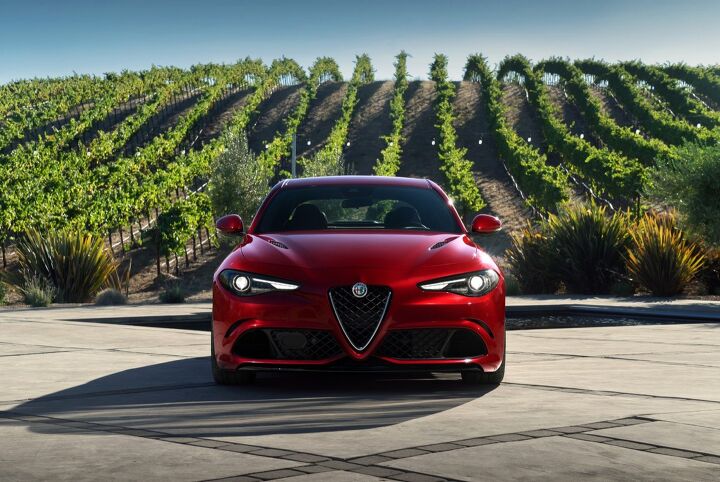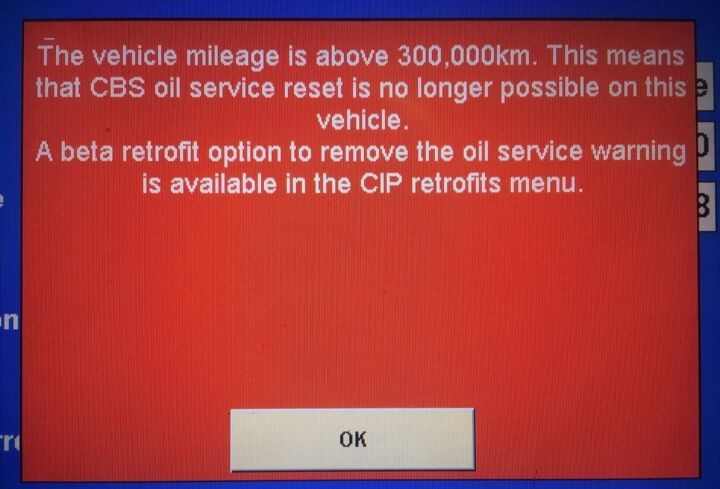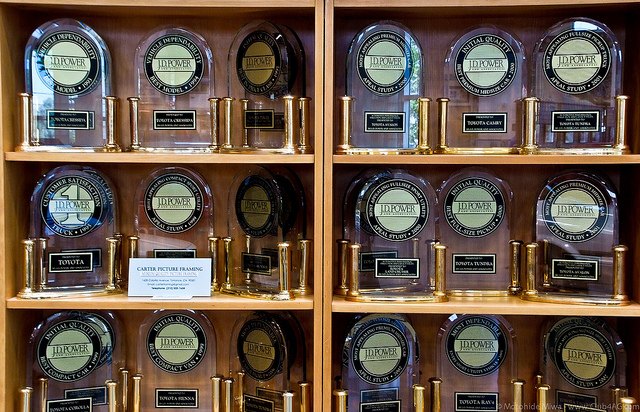#quality
Somehow, Jalopnik's 2017 Alfa Romeo Giulia Quadrifoglio Didn't Break Down, But It Sure Wasn't Exactly Perfect
Jalopnik published its review of the 2017 Alfa Romeo Giulia Quadrifoglio (man, Quadrifoglio takes forever to type) and the world discovered that Jalopnik’s Giulia did not require a tow truck.
That sounds terribly sarcastic, but we wouldn’t be compelled to point out the relative reliability of Jalopnik’s Giulia Quadrifoglio (my goodness, Quadrifoglio takes forever to type) if Giulias hadn’t failed so miserably at other prominent publications in the recent past.
Jalopnik’s 2017 Alfa Romeo Giulia Quadrifoglio didn’t struggle with remote starts, spend time getting fixed at a dealer, stall while parking, or die in traffic. Bless its thumping Italian heart. But Jalopnik’s Giulia Quadrifoglio was far from perfect. Editor-in-chief Patrick George says he doesn’t care: “I am willing to do what the Alfisti have done for decades and chalk up most of its flaws to that thing that is so elusive in modern cars: character.”
But George told me yesterday, “It’s not weirdo enthusiasts like me that Alfa Romeo has to convince. It’s normal folks who might otherwise buy a BMW or a Lexus.”
“And they’re not going to put up with these issues.”
QOTD: Where Do You Want Them To Skimp?
You know how I know that things are getting pretty good in the automotive world? Because we’ve gone from a world where new cars lock their brakes and ignite their gas tanks and delaminate their tires with murderous yet monotonous regularity to a world where people get authentically upset when the fake stitching on their dashboard doesn’t look convincing enough. Our grandparents expected to have to grease their axles every thousand miles and rebuild their engines every 50,000, but we’ve turned into princesses whose posteriors are perfectly primed to detect the mere suggestion of a spherical inconsistency ten mattresses down.
I’m not just talking about the boss man here at TTAC being triggered by a wobbly hood release. I’ve been complaining about the paint and carpet in my Accord for three years now. Prior to that, I recall being very disappointed in the fact that one of my Phaetons only had the stamped-steel parallelogram trunk arms instead of the forged Campagnolo pieces that my other car had. It kept me up at night. I didn’t like opening my trunk in any sort of elevated company.
Of course, we’re not so quick to complain about getting 270 horsepower in the Accord that used to come with 110, or the five LCD screens that replaced plain mechanical gauges, or the vastly better NVH isolation. We want Rolls-Royce interiors and W126 mechanicals at Kia Rio price points. That’s because we now live in a consumer culture where we define ourselves by what we consume, not by what we produce. And it’s also because we’re kind of stupid about how the automotive sausage is made.
The truth of the matter is that all modern automakers skimp. They skimp all over the place, on all sorts of things, and they hope to heaven that you either don’t notice or don’t care. This is true whether we’re talking about the Chevy Sonic or the Bentley Mulsanne. You just have to pick and choose where you’re willing to have the skimping take place. Which reminds me of a great story about the 1996 Taurus …
General Motors Not Giving a Damn in Three Photos
It wasn’t long ago that the Detroit Three were fending off the Japanese on home soil as the Land of the Rising Sun cranked out reliable car after reliable car for the American masses. Then came the Koreans — Kia and Hyundai — who brought over cheap metal to win market share but quickly turned around their quality and reliability woes and produced some of the best products in the industry.
So why is it that, after 108 years of building automobiles, General Motors still manufactures abysmal garbage?
BMW Basically Claims Its Vehicles Are Disposable
Manufacturers want you to believe that their vehicles are durable, but at the same time they want to make money. So, they make continuous improvements and updates in order to keep buyers coming back. Setting a hard limit for how long a vehicle should last would be detrimental to any brand, but soft limits — like the five-digit odometers of the 60s and 70s — made owners aware that they should dump their car before the 100,000 mile mark rolls around.
We’re well into six digit territory now, as the commonly accepted lifetime for vehicles has doubled to 200,000 miles. However, according to its service software BMW thinks its cars shouldn’t be on the road that long.
Leading From Behind: Vehicle Seat Comfort and Owner Loyalty
Are comfortable seats the secret behind the popularity of the Jeep Compass/Patriot siblings?
Many would argue that rock-bottom pricing and a lack of knowledge of better choices could have something to do with it, but a study by J.D. Power finds that drivers stay loyal if their seats treat them right.
Porsche (Go Figure) Ranked Most Appealing Brand in J.D. Power Study
This must be getting boring for the guys and gals in Stuttgart.
For the 12th year in a row, Porsche ranked first in J.D. Power’s new vehicle appeal study, but other automakers are closing in on its crown.
This year’s Automotive Performance, Execution and Layout (APEAL) study found that driver-assist safety features cause drivers to fall in love with their vehicles. They also bore friends and co-workers by talking about it all the time.
J.D. Power Initial Quality Study: Considering a Porsche? Kia's the One You Want
If you’re planning to buy a new vehicle this year, J.D. Power wants you to know you’ll probably happier in a Kia than a Porsche.
Well, maybe less annoyed. By the little things. On average. That’s one takeaway from the firm’s annual ranking of automotive brands based on consumer complaints logged during the first 90 days of ownership.
This year’s J.D. Power U.S. Initial Quality Study is good PR for many automakers, considering 21 of the 33 brands moved up in the rankings this year, including those in the Big Three. Domestic brands collectively recorded a lower problem tally than their foreign competition, a feat only accomplished one other time in the study’s three decade history.
Toyota Ranks First in Brand Value, Volkswagen Plummets
When it comes to brands that resonate with buyers, no other automaker tops Toyota, according to a recent study.
In its annual ranking, BrandZ Top 100 Most Valuable Global Brands shows the Japanese automaker rising two spots to place 28th out of all companies in 2015. Second and third-place automakers BMW and Mercedes-Benz both gained ground in the rankings.
TTAC News Round-up: Toyota Brings on Brains, Sergio Leaves the Cake in the Oven, and GM Takes the Stand
The brain trust of yet another artificial intelligence technology startup has been snapped up as automakers prepare for our terrifying, dystopian future.
That, Sergio Marchionne has a sure-fire recipe, jury selection begins in ignition trial, Tesla doesn’t need no stinkin’ successful low-priced car, and GM goes big on commercial sales … after the break!
Hammer Time: The Real Cost of Being a Car Guy
Forgive me father, for not only have I sinned (at least for right now), but I’m going to make a sordid confession about my daily work life that will tick off 99 percent of the people here.
I find that auto enthusiasts — that’s you — are completely irrational. In fact, sometimes you’re just plain nuts.
It has nothing to do with conspiracy theories, the federal government, or the fact that every manufacturer wants us enthusiasts to become mindless traders and renters instead of long-term keepers. What it really comes down to is that most auto enthusiasts I know simply act like emotional fools.
Ask the B&B: Do Bad Panel Gaps Mean Poor Vehicle Quality?
These photos are of a vehicle that recently visited my driveway for a week. I’m not going to tell you what that vehicle is — yet — but it does raise a very interesting question.
Are bad panel gaps an indicator of a poor quality product? And what “quality” are we talking about anyway?
Hammer Time: What Car Would You Keep for 25 Years?
Nissan Halts Sales on Some Maximas for Quality Issues
Nissan has told its dealers to stop selling specific models of the Maxima due to unspecified quality issue, Automotive News is reporting.
The issue involves Maximas with a specific VIN, not a model type. It’s unclear if those cars have been delivered to dealers or customers. According to Automotive News, Nissan hasn’t identified how many models would be affected by the stop-sale, nor how many of the models may have already been sold.
Nissan hasn’t made available details about the VIN number or how to identify the held cars.
A Denver-area Nissan dealer said he wasn’t aware of the stop-sale at all.
Apple Adds Former Chrysler VP for Car Project - or Not
Doug Betts, former senior vice president at Fiat Chrysler Automobiles in charge of quality, quietly began work at Apple this month, the Wall Street Journal is reporting.
Betts, who led the effort to turnaround Chrysler’s quality rankings beginning in 2009, left the car company last year one day after Consumer Reports ranked the car company near the bottom of its quality survey.
Betts’ LinkedIn page confirms the appointment at Apple, but the famously secret computer company won’t say whether he’s working on an automotive-related project — or perhaps, janitorial duty.
Piston Slap: A Tale of Mastercrafted, Aftermarket Dubs
Jimmy writes:
I hope this new year finds you well. Back in 2007 I bought a new Hyundai Santa Fe. Nothing special, no ABS or four wheel drive. But it did have 20”s on it with low profile 12 inch wide tires. Later that year I had the chance to drive it in the snow. First time ever. Was not a good time.





























Recent Comments